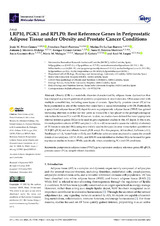LRP10, PGK1 and RPLP0: best reference genes in periprostatic adipose tissue under obesity and prostate cancer conditions
Autor
Pérez Gómez, J.M.
Porcel-Pastrana, Francisco
luz borrero, Marina De La
Montero-Hidalgo, Antonio J.
Gómez-Gómez, E.
Herrera-Martínez, Aura D.
Guzmán-Ruiz, Rocío
Malagón, María M.
Gahete Ortiz, Manuel D.
Luque, Raúl M.
Editor
MDPIFecha
2023Materia
Periprostatic adipose tissue (PPAT)Gene expression analysis
Reference genes
RT-qPCR
Prostate cancer (PCa)
Weight-related disorders
METS:
Mostrar el registro METSPREMIS:
Mostrar el registro PREMISMetadatos
Mostrar el registro completo del ítemResumen
Obesity (OB) is a metabolic disorder characterized by adipose tissue dysfunction that has emerged as a health problem of epidemic proportions in recent decades. OB is associated with multiple comorbidities, including some types of cancers. Specifically, prostate cancer (PCa) has been postulated as one of the tumors that could have a causal relationship with OB. Particularly, a specialized adipose tissue (AT) depot known as periprostatic adipose tissue (PPAT) has gained increasing attention over the last few years as it could be a key player in the pathophysiological interaction between PCa and OB. However, to date, no studies have defined the most appropriate internal reference genes (IRGs) to be used in gene expression studies in this AT depot. In this work, two independent cohorts of PPAT samples (n = 20/n = 48) were used to assess the validity of a battery of 15 literature-selected IRGs using two widely used techniques (reverse transcription quantitative PCR [RT-qPCR] and microfluidic-based qPCR array). For this purpose, ΔCt method, GeNorm (v3.5), BestKeeper (v1.0), NormFinder (v.20.0), and RefFinder software were employed to assess the overall trends of our analyses. LRP10, PGK1, and RPLP0 were identified as the best IRGs to be used for gene expression studies in human PPATs, specifically when considering PCa and OB conditions.

